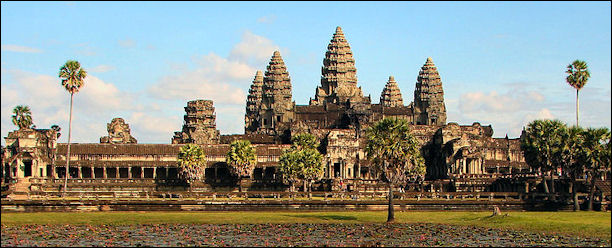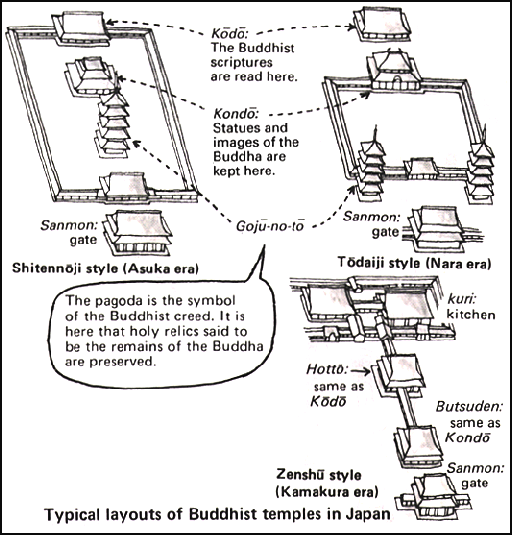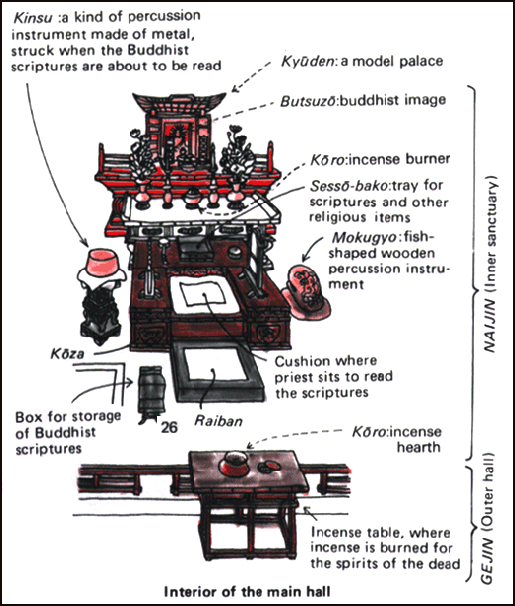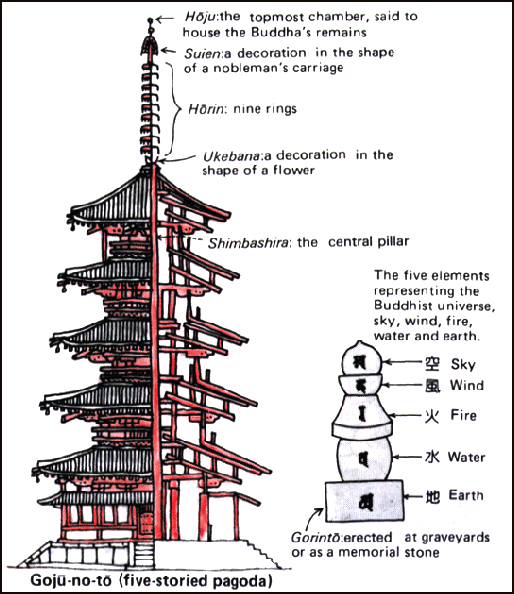BUDDHIST TEMPLES

Mahabodhi Temple Complex in Bodhgaya, where Buddha experienced his enlightenment
A temple is a place of worship as opposed to a shrine, which is a sacred place for praying. It generally contains an image of Buddha and has a place where Buddhists practice devotional activities. Temples attract large crowds during festivals or if they are famous but otherwise a fairly quiet. They are often sought as places for quiet meditation, with most acts of worship and devotion being done in front of an altar at home.
Buddhist temples are generally a cluster of buildings — whose number and size depends on the size of the temple — situated in an enclosed area. Large temples have several halls, where people can pray, and living quarters for monks. Smaller ones have a single hall, a house fore a resident monk and a bell. Some have cemeteries.
Temples can be several stories high and often have steeply sloped roofs are often supported by elaborately-decorated and colorfully-painted eaves and brackets. The main shrines often contain a Buddha statue, boxes of sacred scriptures, alters with lit candles, burning incense and other offerings as well as images of Buddhas, Bodhisattvas and devas. The central images depends on the sect.
Temples and stupas are the main kinds of Buddhist structures. Temples have an open interior that may be entered and in which are displayed one or more cult images as a focus for worship. Stupas are solid structures that typically cannot be entered and were constructed to contain sacred Buddhist relics that are hidden from view (and vandals) in containers buried at their core or in the walls. Although this simple distinction between Stupa and temple is useful, the distinction is not always clear. There are stupas that have the external form of a stupa but are like a temple with an inner corridor and multiple shrines.
Buddhist temples come in many shapes and sizes. Pagodas found in China and Japan are perhaps the best known. Stupas, stone structure built over Buddhist scriptures or relics of the Buddha or famous holy men, are found throughout the Buddhist world. . Buddhist temples are designed to symbolise the five elements: 1) Fire, 2) Air, 3) Earth, symbolised by the square base, 4) Water, and 5)Wisdom, symbolised by the pinnacle at the top of the temple. All Buddhist temples contain an image or a statue of Buddha. [Source: BBC]
See Separate Articles: BUDDHIST ARCHITECTURE: BUILDINGS, TEMPLES, STUPAS, FEATURES factsanddetails.com TIBETAN ARCHITECTURE: TEMPLES, PALACES, STUPAS factsanddetails.com ; THERAVADA BUDDHIST TEMPLES (WATS), ARCHITECTURE AND TEMPLE RITUALS factsanddetails.com ;BURMESE ARCHITECTURE factsanddetails.com ; ANGKOR WAT factsanddetails.com ; Also see articles on temples under religion in Tibet, Japan, and China and articles on Monasteries and Monastery Architecture

Shwedagon pagoda in Yangoon, Myanmar
Websites and Resources on Buddhism: Buddha Net buddhanet.net/e-learning/basic-guide ; Internet Sacred Texts Archive sacred-texts.com/bud/index ; Introduction to Buddhism webspace.ship.edu/cgboer/buddhaintro ; Early Buddhist texts, translations, and parallels, SuttaCentral suttacentral.net ; East Asian Buddhist Studies: A Reference Guide, UCLA web.archive.org ; View on Buddhism viewonbuddhism.org ; Tricycle: The Buddhist Review tricycle.org ; BBC - Religion: Buddhism bbc.co.uk/religion
Buddhist Art: Buddhist Symbols viewonbuddhism.org/general_symbols_buddhism ; Wikipedia article on Buddhist Art Wikipedia ; Asian Art at the British Museum britishmuseum.org; Buddhism and Buddhist Art at the Metropolitan Museum of Art metmuseum.org ; Buddhist Art Huntington Archives Buddhist Art dsal.uchicago.edu/huntington ; Buddhist Art Resources academicinfo.net/buddhismart ; Buddhist Art, Smithsonian freersackler.si.edu ; Asia Society Museum asiasocietymuseum.org
RECOMMENDED BOOKS:
“Buddhist Architecture” by Le Huu Phuoc Amazon.com ;
“Buddhist Art and Architecture” by Robert E. Fisher Amazon.com ;
“Borobudur: Golden Tales of the Buddhas” by John N. Miksic, Anita Tranchini, et al. Amazon.com ;
“Borobudur: Majestic Mysterious Magnificent” by John N. Miksic, Amazon.com ;
“Buddhist Temples of Kyoto and Kamakura” by Beatrice Lane Suzuki and Michael Pye Amazon.com ;
The Four Great Temples: Buddhist Archaeology, Architecture, and Icons of Seventh-Century Japan” (2008) by Donald F. McCallum Amazon.com;
Nara Buddhist Art, Todai-Ji: 5 (Heibonsha Survey of Japanese Art)
by Takeshi Kobayashi Amazon.com;
“How to Read Buddhist Art” (The Metropolitan Museum of Art - How to Read)
by Kurt A. Behrendt Amazon.com ;
“Reading Buddhist Art: An Illustrated Guide to Buddhist Signs and Symbols” by Meher McArthur Amazon.com ;
“The Encyclopedia of Tibetan Symbols and Motifs” by Robert Beer Amazon.com;
“The Tibetan Iconography of Buddhas, Bodhisattvas, and Other Deities: A Unique Pantheon” by Lokash Chandra and Fredrick W. Bunce Amazon.com
“Buddhist Art: An Historical and Cultural Journey” by Giles Beguin Amazon.com ;
“Tree & Serpent: Early Buddhist Art in India” by John Guy Amazon.com ;
“Early Buddhist Narrative Art: Illustrations of the Life of the Buddha from Central Asia to China, Korea and Japan” by Patricia E. Karetzky Amazon.com;
“Pilgrimage and Buddhist Art” by Adriana Proser, Susan Beningson Amazon.com ;
“The Buddhist Art of China” by Zhang Zong Amazon.com;
“Cave Temples of Dunhuang: Buddhist Art on China’s Silk Road”
by Neville Agnew, Marcia Reed, et al.
Amazon.com;
“Cave Temples of Mogao at Dunhuang: Art and History on the Silk Road”
by Roderick Whitfield, Susan Whitfield, et al Amazon.com;
History of Buddhist Temples
The word for temple in many languages is the same as cave. Many early Buddhist temples were "artificial caves" that attempted to recreate the atmosphere of Buddhist caves in northern India. Describing what they were probably like, the historian Paul Strachen wrote: In his book “Pagan: Art and Architecture of Old Burma” , "the now spartan brick “gu” [temple]" was "cluttered with regal objects and requisites, a clamor of activity as food offerings were shuttled from the kitchens down passageways crowded with chanting devotees, brightly colored wall paintings, gilded furnishings and flapping banners and hangings...the usual plain, seated Buddha image, found in the deserted temples of Pagan today, would have been bathed, perfumed and dresses with the finest and most costly garments."
The architecture of Buddhist temples is influenced by the architecture of country in which they are found and various traditions of Buddhist architecture. Japanese pagodas, for example, have unique Japanese features that are modeled after Chinese-style pagodas, which in turn were modeled after Indian stupas.
Because ancient wood temples were often destroyed by fire, temples today are usually made of brick and stone with brass and iron ornaments. Chinese pagodas were often built to commemorate important leaders or event or house important artifacts or documents.
Many Buddhist temples are located in the forests and mountains. There are two reason for their remote locations: first, mountains and forest have always been associated with spiritual purity, and second, Buddhist monks were often persecuted and remote location gave them some safety. In China, Japan and Thailand temples are often in the middle of town.

Angkor Wat, a Hindu-Buddhist temple
Activities at Buddhist Temples
People sometimes donate money to temples and have their names hung on special wooden plaques attached to lanterns of the temple. Generally, the larger the donation, the larger the plaque. Buddha never viewed himself as an object of worship. He probably would not have been very pleased to see his birthday as the object of veneration and merit so crassly exchanged for money.
Many temples are tourist attractions and outing destinations for local people. Souvenir amulets and other offerings are sold in little shops or booths; the names of large contributors are placed in special boxes; and priests are available to perform special rites. There are essentially three kinds of Buddhist structures: 1) stupas, bell-shaped structures that contain a holy relic or scripture; 2) temples, place of worship somewhat similar to a church; and 3) monasteries, which contain living quarters and meditation cells for monks.
Buddhist temples generally have statues of the Buddha or bodhisattvas (Buddha-like, semi-deities). These are sometimes used as aids to meditation. In China and Japan, some Buddhist temples are called pagodas and are built several stories high, with a curved roof and a tower on top. Some Buddhist temples are built to symbolize the five elements: water, air, fire, earth, and wisdom. The base of such temples is square, symbolizing the earth, and comes to a point at the top, representing wisdom. [Source: Encyclopedia.com]
Temples often serve the dual purpose of both religious and cultural centers for the faithful. People generally remove their shoes before entering a Buddhist temple as a sign of respect. While Theravada Buddhists typically go to temples for uposatha (Buddhist days of observance in line with moon phases) and for festivals, Mahayana Buddhists go to temples whenever they choose, making offerings and praying to various images. Stupas also serve as places of worship.
Local temples are essentially self sufficient and rely on their own lands and support from the local lay community to keep going. Property belongs to the community. There is not a hierarchy of priest, bishops and archbishops like there is Christianity. The word pagoda is sometimes used to collectively describe stupas and temples but generally refers to Japanese- and Chinese style towers inspired by South Asian stupa. The word pagoda is derived from “dagada” , the word used for relic chamber in Sri Lanka. Classic Japanese- and Chinese-style pagodas usually have multiple stories, each with a graceful, tiled Chinese-style roof, and a top roof capped by a spire. The base represents the earth, the spire symbolizes heaven, and the connecting piece symbolizing the cosmic axis, to the Way.

Features of Buddhist Temples
Buddhist temples usually contain numerous Buddha statues. The central Buddha images are often surrounded by burning incense sticks and offerings of fruit and flowers. Some contain the ashes or bone reliquaries of popular holy man. Many Buddhist temples face south and sometimes to the east, but never to the north and west which are regarded as unlucky directions according to Chinese feng shui. Many temples are entered through the left door and exited through the right.
The main hall is usually found at the center of the temple grounds. Inside are images of the Buddha, other Buddhist images, altars and space for monks and worshipers. The main hall is sometimes connected to a lecture hall, where monks gather to study and chant sutras.. Other buildings include a the sutra depositor, a library or place where Buddhist scripture are kept; living, sleeping, and eating areas for monks, and offices. Large temples often have special halls, where treasures are kept and displayed.
Some temples have shrines for making prayers to the dead filled with funerary plaques with photographs of dead relatives. The photographs are often of deceased people whose funeral ceremony was performed at the temple. Some temple feature sets of wooden plaques with the names of large contributors and other sets with afterlife names of deceased people. In the old days the afterlife names were only given only to Buddhist priests but now they are given to lay people who paid the right price and now in some places have become a kind of ranking system in the after life based in how much one has contributed..
Many Buddhist temples contain large bells, which are rung during the New Year and to mark other occasions, and cemeteries. The pathway to the temples is often lined with stone or paper lanterns donated by worshipers, or strung with prayer flags. Many temples are filled with small shops selling religious items.
Buddhist Temple Gates
Buddhist temples usually have outer gates and inner gates protected by statues or paintings of beasts, fierce gods, or warriors that ward off evil spirits. The gateways are composed of wood, stone, bronze or even concrete. The beasts include Chinese lions and Korean dogs. Fierce guardian gods and warriors on the outer gate sometime have lighting bolts coming out of their nostrils and a serrated swords in their hands. Their duty is to keep demons and evil spirits out of the temple area.

The inner gate at the antechamber to the temple complex is often guarded by four guardian kings, representing the four cardinal directions. The king in the north holds a pagoda representing earth, heaven and cosmic axis. The king in the east holds a sword with the power to evoke a black wind that produces tens of thousands of spears and golden serpents. The king in the west possesses lute. And the king in the south holds a dragon and a wish-fulfilling jewel.
Some demon statues are covered with spitballs from worshipers who wrote prayers or petitions on pieces of paper, chewed them, and threw them on the demon statues in hope that the prayers would be answered. Usually they are fold paper.
Chinese Buddhist Temples
Buddhist temples are generally a cluster of buildings — whose number and size depends on the size of the temple — situated in an enclosed area. Large temples have several halls, where people can pray, and living quarters for monks. Smaller ones have a single hall, a house for a resident monk and a bell. Some have cemeteries.
Patricia Buckley Ebrey of the University of Washington wrote: “ Before the end of the fifth century there were reportedly more than 10,000 temples in China, north and south. Some were undoubtedly small, modest temples, but in the cities many were huge complexes with pagodas, Buddha halls, lecture halls, and eating and sleeping quarters for monks, all within walled compounds. These temple complexes provided a place for the faithful to come to pay homage to images of the Buddhas and Bodhisattvas and meet with clergy. [Source: Patricia Buckley Ebrey, University of Washington, depts.washington.edu/chinaciv /=]
The best evidence of the interior decoration of early temples is found in the surviving cave temples. Although only a few wooden buildings have survived from the Tang period or earlier, hundreds of cave temples have survived. Here we offer glimpses of the three most famous cave temple complexes, Dunhuang in Gansu Province, Yungang in Shanxi Province, and Longmen in Henan Province.
“The temples at which most Chinese monks and lay Buddhists worshipped were made of wood, built to last at most a few centuries. Some were in the mountains, built for monks who wished to remove themselves from the clamor of everyday life. Lay Buddhists might make pilgrimages to these mountain temples, but there were also Buddhist temples much closer at hand in every town and city. There are no extant urban temple complexes dating from Tang times, though there are some in Japan that were based on Chinese models. “
Temples can be several stories high and often have steeply sloped roofs that are supported on elaborately-decorated and colorfully-painted eaves and brackets. The main shrines often contain a Buddha statue, boxes of sacred scriptures, alters with lit candles, burning incense and other offerings as well as images of Buddhas, Bodhisattvas and devas. The central images depends on the sect.
Buddhist temples usually have red pillars while Taoist temples have black ones. Just inside a Buddhist temple gates are statues or images of the Four Heavenly Kings of the Four Directions and Maitreya, the chubby laughing Buddha. The main hall features three large statues seated on lotus flowers: the Buddhas of the past, present and future. Behind them is often a statue of Guanyin, the multi-armed Goddess of Mercy.
Many temples are funded by donations with large amounts of money for prestigious temples coming from Buddhists in Hong Kong and Taiwan and elsewhere around the world. Some Chinese Buddhist temples invite Tibetan monks in an effort to attract to more followers.
See Separate Articles CHINESE BUDDHIST TEMPLES AND MONKS factsanddetails.com; CHINESE TEMPLES factsanddetails.com

Fawant Temple, second oldest in China
Japanese Buddhist Temples
There are 70,000 Buddhist temples in Japan. They are places of worship not shrines (sacred places for praying). Shrines are usually associated with Shintoism. A temple generally contains an image of Buddha and has a place where Buddhists practice devotional activities. Temples attract large crowds during festivals or if they are famous but otherwise a fairly quiet. They are often sought as places for quiet meditation, with most acts of worship and devotion being done in front of an altar at home.
Buddhist temples are generally clusters of buildings, whose number and size depends on the size of the temple. Large temples have several halls, where people can pray, and living quarters for monks. Smaller ones have a single hall, a house for a resident monk and a bell. Some have cemeteries.
The architecture of Buddhist temples is influenced by the architecture of Korea and China, the two countries that introduced Buddhism to Japan.
Early Japanese Buddhist temples consisted of pagodas, which were modeled after Chinese-style pagodas, which in turn were modeled after Indian stupas. Over time these pagodas became one building in a large temple complex with many buildings.
Buddhist temples built in the 7th century featured vermillion-painted columns and eaves supported and decorated with mythical beasts sculpted in "dry-lacquer" (layers of hemp cloth glued together and covered with lacquer) or guilt bronze. Unfortunately no original examples of this style of architecture remains. The earliest Buddhist paintings had a strong Indian influence.
Large Kyoto temples, such as Chionin temple — the head temple of Jodoshu Buddhism? have no danka (community-support system) and are run like large companies. The 150 priests who work at Chionin receive a salary from the temple. The majority of the salaried priests have their own small temples elsewhere, but the support of their danka alone is not enough. They use their Chionin salaries to subsidize their own small temples, much like Sakakibara used his salary from the university to sustain his temple.
See Separate Article BUDDHIST TEMPLES IN JAPAN factsanddetails.com

Japanese style pagoda
Borobudur: the Ultimate Buddhist Temple
Borobudur, in Central Java, Indonesia, is the biggest Buddhist monument in the world. It was built during over a half century by the Sailendra Dynasty after Mahayana Buddhism was introduced from the Srivijaya Kingdom of South Sumatra in the early half of the 8th century AD. Many Buddhism images and reliefs in Borobudur were made referencing Gandavyuha and Vajrayana/Esoteric Buddhism from Sri Lanka and East India. [Source: Takashi Sakai, Nihon Kôkogaku, May 20, 2008]
The stepped pyramid shape without an inner space as found at Borobudur is found in neither India nor Sri Lanka. And there are no stupas with that similar shape in Southeast Asia prior to Borobudur. Similar shaped monuments are found only in South Sumatra etc. This type of monument, originating from the mountain religions of Megalithic culture that predated the introduction of Buddhism continued through the Historical Age. Borobudur can be seen as a massive monument of this origin, decorated in Buddhism style.
Borobudur, ranks with Pagan in Myanmar and Angkor Wat in Cambodia as one of the great archeological sites of Asia, if not the in world. The eminent Dutch archaeologist A.J. Bernet Kempers called it "a Buddhist mystery in stone. An actual meeting of Mankind and the Holy. A shining tower of the law." It’s name is derived from the Sanskrit word "Vihara Buddha Uhr" which means "Buddhist monastery on the hill." Borobudur is located in Muntilan, Magelang, in the Kedu Valley, in the southern part of Central Java. It is about 100 kilometers from Semarang.
Borobudur is a square 123 meters (403 feet) on each side and 32 meters (105 feet) high.Constructed of unmortared grey andosite and volcanic basalt stone and surrounded by lush green fields of the Kedu Plain and tourist infrastructure, it is about the size of a stadium, and took about 80 years to build. Four large volcanos, including the often-smoking Mount Merapi, and numerous hills are visible in the distance. The temple’s design in Gupta architecture reflects India's influence on the region, yet there are enough indigenous scenes and elements incorporated to make Borobudur uniquely Indonesian. The monument is decorated with 2,672 relief panels and 504 Buddha statues.
Borobudur is a step pyramid, built around a natural hill, comprised of a broad platforms topped by five walled rectangular terraces, and they in turn are topped by three round terraces. Each terraces is outlined with ornaments and statues and the walls are decorated with bas reliefs. More than two million blocks of volcanic stone were carved during its construction. Pilgrims have traditionally walked around the monument in a clockwise manner moving up each of the five levels, and in process covering five kilometers.
See Separate Article BOROBUDUR factsanddetails.com

Borobudur, northwest view
Wats (Buddhist Temples in Southeast Asia)
A wat is a monastery temple in Thailand, Cambodia, or Laos set up as a place where men and women can be ordained as monks and nuns. “Wat” is a Thai word of Pali-Sanskrit derivation that means "school" or more accurately “dwelling” for students and monks. Almost every town, village precinct has at least one. Without an ordination area, which is designated by special markers, a building is technically not a wat but rather a residence for monks and nuns.
Strictly speaking a wat is a Buddhist sacred precinct with monks' quarters, the temple proper, an edifice housing a large image of Buddha, and a structure for lessons. A Buddhist site without a minimum of three resident monks cannot correctly be described as a wat, although the term is frequently used more loosely, even for ruins of ancient temples. (As a transitive or intransitive verb, wat means to measure, to take measurements; compare templum, from which temple derives, having the same root as template.) [Source: Wikipedia; “Culture Shock! Thailand “ ]
See Separate Articles WATS (TEMPLES) AND THERAVADA BUDDHIST RELIGIOUS BUILDINGS IN THAILAND factsanddetails.com
Image Sources: Wikicommons Media, Japanese National Tourist Organization
Text Sources: “World Religions” edited by Geoffrey Parrinder (Facts on File Publications, New York); “Encyclopedia of the World’s Religions” edited by R.C. Zaehner (Barnes & Noble Books, 1959); “Encyclopedia of the World Cultures” edited by David Levinson (G.K. Hall & Company, New York, 1994); “The Creators” by Daniel Boorstin National Geographic articles. Also the New York Times, Washington Post, Los Angeles Times, Smithsonian magazine, Times of London, The New Yorker, Time, Newsweek, Reuters, AP, AFP, Lonely Planet Guides, Compton’s Encyclopedia and various books and other publications.
Last updated January 2024
